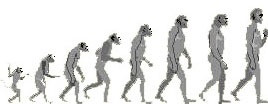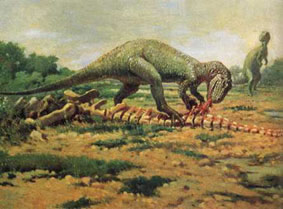ourorigin
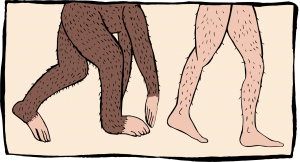
Did it ever occur to you that all the people you know and all the people you don’t know, rich or poor, at one time have been babies that came out of their mother’s womb? And that all those mothers have in their turn been babies born from their mothers? This way you can go back in history from mother to grandmother to great grandmother and so on. The time needed for a woman to grow up and get a child is called a generation. Right now women have their first child on average at age twenty-five; a hundred years ago at twenty. Let’s say it takes about five hundred generations of mothers to go back ten thousand years.People that lived ten thousand years ago certainly would be dazzled if they could take a look at all the new discoveries that have made our lives so much easier than theirs, but in every other way they were much the same as we are. They spoke a language, and had a religion and cultural values that were transmitted to the younger generation.
Ten thousand years ago
Let’s take a closer look at our ancestors of ten thousand years ago. They live in a group or tribe in order to better protect themselves against the dangers of predators and invaders. They may be nomadic hunters or settlers on land, growing corn and roots and creating villages and towns. The men go hunting and fishing for food and are responsible for the defense of the community; the women work the land, take care of the kids and the sick, do the cooking, make clothes and medicines. Men and women also work together, dividing the tasks according to sexual stereotypes. They use simple tools like arrows, axes, baskets, pots and needles and are able to make a fire. When we get to know them a little better we find that they have the same emotions we do: they are happy or sad, get mad and scared, they fall in love and are jealous and aggressive. They also wonder about the meaning of their existence and have developed a religion that is at the same time their science, because it explains the world around them. Thus they have ideas about the sun, moon and stars, about how the earth, humans and animal life were created, how things interact with each other. In order to help prevent disasters or to induce good luck for hunt and harvest, health and fertility, they make sacrifices to pacify the gods that rule over them. Not only gods, but also ancestors play an important role: they are worshipped and feared. Ceremonies and celebrations are an opportunity to create beautiful things and have fun together. There is a power structure: the leadership is in the hands of an older male or sometimes a female, assisted by a council of wise people. There are all sorts of rules that people have to live by, and when a tribe member does something that is considered wrong or disruptive of community-life, they are punished.
Although humans of ten thousand years ago lived more primitively than we do, they were just like us in their basic make-up, mentally, socially, emotionally. They, like us, are called Homo Sapiens (The Knowing Human). It is thought that Homo Sapiens has been around for at least 40 or 50 thousand years. The Homo Sapiens mothers also came from their mothers, as they did from theirs, and so on. This is the line of life that connects us to the most distant past. As we move further back in history, from mother to mother, we follow our evolution backwards, as it were, and see gradual changes taking place in the characteristics of humans. Let’s take a big step back in time from the familiar Homo Sapiens, passing by ten thousand generations of mothers.
Two hundred thousand years ago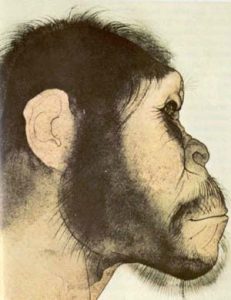
Going back ten thousand generations of mothers, or two hundred thousand years, we meet humans that are sufficiently different from Homo Sapiens to give them a separate name. We do not know that name. Fossils of early humans living at that time are probably not directly related to us, but to a common ancestor. Anyway, these people, to whom we are directly linked through generations of mothers, are clearly human. They walk around on two legs with their hands free to carry things, to gesture, to build and create. But are shorter, more hairy than we are; they have a lower forehead, wider nostrils, a more protruding jaw, and their ears are placed higher. They face a lot of dangers: their life is marked by fear and they are always on the alert to defend themselves. It is hard to find them because they live in caves or in hiding places, where they form families of one or more men and several women with children. They are obviously human in appearance and behaviour, their brain and hands enable them to do more cultural things than any animal, like using fire and speech. Although their language is limited, and some speak better and others hardly at all, the men share knowledge about where to find a prey, how to attack other men or defend themselves. The women share their knowledge and experience with the children and each other. In their communication they use a lot of gestures and expressive sounds to share emotions like fear, anger, joy and sorrow. (Imagine how it is to talk with a one and a half year old or someone from a foreign country: language works only very partially and you use tone, clear facial expression, hands and feet to understand each other). The language contains a few very powerful words that everyone knows, expressing fear of imaginary forces. So these people of two hundred thousand years ago would still be very familiar to us. In fact, when we look closely at ourselves, we realize that basically, in our emotions, relations, family life, sexual distinctions and in the world of power, achievement and conflict, we are very much like them. And let’s not forget, also in those days babies came out of their mothers’ vaginas. Let’s go back go back another hundred thousand generations of mothers, which is about two million years.
Two million years and beyond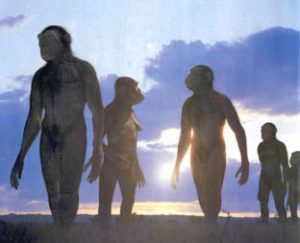
Our human ancestors of so long ago are considerably smaller than we are and walk less upright. A full-grown adult is no taller than a twelve-year-old in our time. Their arms are longer, their faces are more ape-like and they have more hair. Unlike apes, who live in the middle of the woods, swinging from branch to branch, humans live at the border, closer to the open fields. They may go hunting in groups or look for half-eaten carcasses left behind by predators. They make more gestures and use a larger variety of different sounds than apes and they look us more directly in the face, and give us a peculiar sense of kinship. Humans and the present apes (chimpanzees, orangutans, gorillas and bonobos) are different species, developed from a common ancestor. The common ancestors of apes and humans had in their turn ancestors, from which all the mammals originated, and they were preceded by the ancestors of all living beings: animals as well as plants. When we observe apes and monkeys in the zoo or in the wild, we experience the common roots we share with them: they play and tease, try to dominate each other, care for their kids and have sex. And don’t we have a similar experience with cats and dogs? We must be related to them, even if that goes back two hundred million years ago. There is a mutual understanding and shared needs for food, sleep, company and curiosity about new and interesting things.
The origin
Two million years is only a short time compared with the history of life. Sixty-five million years ago, the last big dinosaurs walked the earth. They had been the dominant species for maybe two hundred million years. The early mammals of this period had to live and hide in places where the dinosaurs and others couldn’t come. Mammals were much smaller at that time: the saber tiger has an ancestor the size of a mouse, and elephants have ancestors as small as pigs. After the dinosaurs became extinct, mammals, the predecessors of mice and cows, horses and dogs, monkeys and humans, gradually grew bigger and smarter. We can go back further in time, along an uninterrupted genetic line of births from you and me to the very first mammals and beyond. Sexual reproduction is much older than the mammals: birds and fish and snails and roaches and bugs and plants do it. Sexual reproduction goes back more than a billion years. Before that there was no sexual reproduction, but only cell division (cloning), in which the mother cell divided itself into two identical daughter cells. The cells of our body still reproduce themselves that way, when we grow from an embryo in the womb to an adult (‘full-grown’) individual. It is also seen in the growth of our nails, hair and new skin. 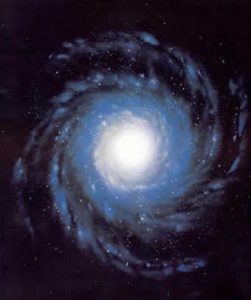
The only cells that do not clone themselves are our sex cells (sperm cells in males and egg cells in females). They must combine with each other to make a new individual. As the male and female cells fuse together, the genetic properties are combined, so that the new individual has properties of both and is also a little different from both. Sexual reproduction has thus brought forth an enormous variety of different species of plants and animals, of which humans are the most complex and advanced. Going further back in time, the question comes up: how did life first start? Three or four billion years ago, large strings of protein molecules (protein still forms the basis of all life forms) somehow started to divide themselves. Those large protein molecules were composed of smaller molecules, which are built from atoms of hydrogen, oxygen and carbon. They, in their turn, consist of elementary parts (quarks and electrons) which are the smallest known building blocks of the universe. So ultimately we are composed of the same matter as all other living beings and all other matter around us. And in the end we will decompose again when we die (individually) or become extinct (as a species).

